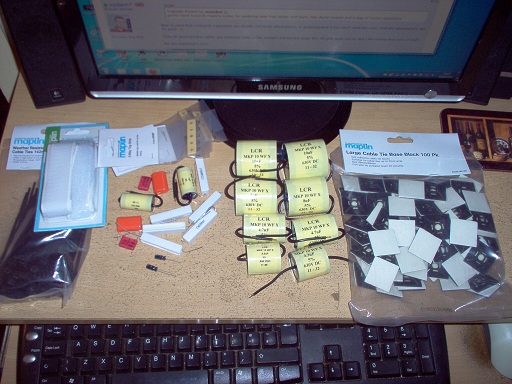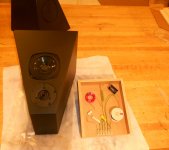Better areas to spend money on, like inductors...

While every and each component in the crossover will make a difference capacitors are the biggest bottleneck...
I would change resistors before inductors, the only inductors that really makes a difference vs a plain air core one are the foil inductors (at too high prices).
I just built 2 pairs xo's the second pair didn't sound as good as the first set. I used Bennic Polypro. (yellow), that's when I re-ordered the clarity caps.
The tweeters were in the $30 range, another $10 bucks is not bad. I don't know if you guys are married....I'd like to spend some before it all gone (if you know what I mean).
btw, The Zaph kits/designs use them a lot.
The tweeters were in the $30 range, another $10 bucks is not bad. I don't know if you guys are married....I'd like to spend some before it all gone (if you know what I mean).
btw, The Zaph kits/designs use them a lot.
Last edited:
This is turning out pretty good....considering these have been to He** and Back (they were outside for a long time).
Re-fit the speaker holes with wood adapter rings and re-painted. The xo will be part of the speaker stand.
The yellow cap looks pretty wimpy (also ordered some better resistors). As just mentioned, the other board(s) sounded better.
The triangle boxes are 1" mdf and lead/foam lined.
Re-fit the speaker holes with wood adapter rings and re-painted. The xo will be part of the speaker stand.
The yellow cap looks pretty wimpy (also ordered some better resistors). As just mentioned, the other board(s) sounded better.
The triangle boxes are 1" mdf and lead/foam lined.
Attachments
I've had pretty good luck with Solen, and have been pretty impressed with Erse as well. I suppose if I built something that had thousands of dollars worth of drivers I might look around for something better, like Clarity ESA or whatever they've got now at Parts ConneXion - The authority on hi-fi DIY parts and components but I have a hard time justifying spending $50 to cross over a $50 driver 
As far as big values, Bennic seems to be popular, but again, if I needed a huge value for a particularly expensive driver, I'd probably go with big poly caps.
For me it's all a balance of how much I spent on the drivers. Might be the wrong thing to do, but *shrug*
As far as big values, Bennic seems to be popular, but again, if I needed a huge value for a particularly expensive driver, I'd probably go with big poly caps.
For me it's all a balance of how much I spent on the drivers. Might be the wrong thing to do, but *shrug*
I swapped a Solen SCR with Jantzen superior Z cap in the HF pass series cap in my crossover and the difference was remarkable. I wasn't expecting much of a change and I am a skeptic when it comes to esoteric parts but in this case it was money well spent.OK Guys,
what are we using for caps when doing x-overs , i'm about to purchase new and was going to use Solens( old time memory and haven't tried any of the new stuff ) whats your favorite brand type and why ...?
regards,
I have used V-Cap OIMP and I like it. Very smooth sound after 200 hours break in.
Oil Impregnated Metalized Polypropylene Audio capacitors by V-Cap
Oil Impregnated Metalized Polypropylene Audio capacitors by V-Cap
Here's one person's assessment of Tony Gee's Humblehomemadehifi cap ratings. It's a bit dated now, but still pretty relavent after over 1300 downloads.
Capacitor voltage rating vs performance - The Classic Speaker Pages Discussion Forums
Capacitor voltage rating vs performance - The Classic Speaker Pages Discussion Forums
While every and each component in the crossover will make a difference capacitors are the biggest bottleneck...
I would change resistors before inductors, the only inductors that really makes a difference vs a plain air core one are the foil inductors (at too high prices).
*Yawn* oh dear the old subjective,"caps all sound different" thread.
I agree with 5th Element on boutique caps.
Last edited:
*Yawn* oh dear the old subjective,"caps all sound different" thread.
*Yawn* oh dear the old skeptical,"caps all sound the same" thread.
I use Solen Fast caps in my creations. Not strictly as XO capacitors but as DC protection caps for my tweeters after an active XO + amp. They don't have a sound when used right, and the price is right if you compare it to the rest of my system.
My personal opinion is that you shouldn't go nuts on capacitors, the most critical part in any passive XO are the coils, after that the capacitors and last the resistors. Coils are the worst because they can pick up magnetic and electric fields and if they have a core other than air can become saturated, caps are more prone to manufacturing differences (try to find a 1% cap, next to impossible), than resistors.
So forget about beeswax, gold, silver and stuff like that and just buy a decent quality cap that suites your needs... Maybe I should add here that I work as an electronics engineer so I might be a bit biased
http://www.diyaudio.com/forums/multi-way/207159-trinium-my-latest-build.html
My personal opinion is that you shouldn't go nuts on capacitors, the most critical part in any passive XO are the coils, after that the capacitors and last the resistors. Coils are the worst because they can pick up magnetic and electric fields and if they have a core other than air can become saturated, caps are more prone to manufacturing differences (try to find a 1% cap, next to impossible), than resistors.
So forget about beeswax, gold, silver and stuff like that and just buy a decent quality cap that suites your needs... Maybe I should add here that I work as an electronics engineer so I might be a bit biased
http://www.diyaudio.com/forums/multi-way/207159-trinium-my-latest-build.html
Last edited:
I'm using a readily available 650V polyproylene type from Maplin in the UK. The 10uF are £10 a pop, so I'm spending about £40 on capacitors and content with my own comparisons and listening tests on various types. This seems a balanced approach since that is of the order of the cost of the tweeters. Good enough, for sure.

Lynn Olson often talks about good technique with capacitors and crossovers. Damped mountings, avoiding microphonics, crosstalk, RF decoupling, putting outer layers in the ground plane, etc. This forum has had goodish discussions on this too. The INDUSTRY is keeping us in the dark it seems. I really haven't seen some ANY serious attempt to demystify the whole business. Any serious radio engineer would use a Null Bridge comparison between capacitors, loudspeaker cables or resistors :
This is the one test we are NOT seeing done. I suspect it would reveal a lot of Snake Oil in all this...

Lynn Olson often talks about good technique with capacitors and crossovers. Damped mountings, avoiding microphonics, crosstalk, RF decoupling, putting outer layers in the ground plane, etc. This forum has had goodish discussions on this too. The INDUSTRY is keeping us in the dark it seems. I really haven't seen some ANY serious attempt to demystify the whole business. Any serious radio engineer would use a Null Bridge comparison between capacitors, loudspeaker cables or resistors :
An externally hosted image should be here but it was not working when we last tested it.
This is the one test we are NOT seeing done. I suspect it would reveal a lot of Snake Oil in all this...
i agree with 5th element, and system7, possibly others. Ive used the maplin PP caps and they are fine. The Wima MKP System7 shows are also fine, albeit small values. I also rate the vishay polyester he shows. Recently ive use the Monacor branded PP caps, lower voltage rating of 250V but adequate, these are the value caps. No electrolytics in my speakers, EVER. even have some 47uf PP caps so i dont get forced into using an electrolytic cap. Those are the same size as a 8uf Maplin PP.
Money is better spent on inductance. If using ferrite, then my POV is to buy the largest wire gauge and current rating, to cut and eliminate core saturation in typical use at my levels. For that cost, you could just go aircore, but wiregauge and DCR is too high. Spend more again and you get large gauge or foil air cored. I see that as my way of costing vs sound. The alphacore air cores were worth every penny and the 6 week wait for the US mail...
Money is better spent on inductance. If using ferrite, then my POV is to buy the largest wire gauge and current rating, to cut and eliminate core saturation in typical use at my levels. For that cost, you could just go aircore, but wiregauge and DCR is too high. Spend more again and you get large gauge or foil air cored. I see that as my way of costing vs sound. The alphacore air cores were worth every penny and the 6 week wait for the US mail...
Last edited:
. I really haven't seen some ANY serious attempt to demystify the whole business.
About 10 yrs ago there was a serious attempt to demystify capacitor's sound. Here's a link for some of you who may not be aware of this very ambitious effort.
Capacitor Sound
Getting rid of the ferrite in a coil is going to be a good thing, though that just leaves the ferrite magnet in a driver to worry about...
Is a bit of series resistance in a coil or capacitor a BAD THING? Not really. It causes a loss of efficiency for sure, but many designs actually rely on that resistance. LCR notch filters, bass rolloff capacitors for instance. To compensate for the resistance of a bass coil and get the cabinet Q right, you make the cabinet a tidge bigger. The old KEF and Celestion bass crossovers get rather peaky at crossover with polypropylenes and work better with non polar electrolytics.
A good engineer turns component deficiencies into FEATURES!
Is a bit of series resistance in a coil or capacitor a BAD THING? Not really. It causes a loss of efficiency for sure, but many designs actually rely on that resistance. LCR notch filters, bass rolloff capacitors for instance. To compensate for the resistance of a bass coil and get the cabinet Q right, you make the cabinet a tidge bigger. The old KEF and Celestion bass crossovers get rather peaky at crossover with polypropylenes and work better with non polar electrolytics.
A good engineer turns component deficiencies into FEATURES!
A good engineer turns component deficiencies into FEATURES!
Or at least works around them
An externally hosted image should be here but it was not working when we last tested it.
This is the one test we are NOT seeing done. I suspect it would reveal a lot of Snake Oil in all this...
Now why would anyone bother with doing real testing when they have built in "golden ears" and don't believe in sighted bias
- Status
- This old topic is closed. If you want to reopen this topic, contact a moderator using the "Report Post" button.
- Home
- Loudspeakers
- Multi-Way
- X-Over capacitors ... What are we using ...?
